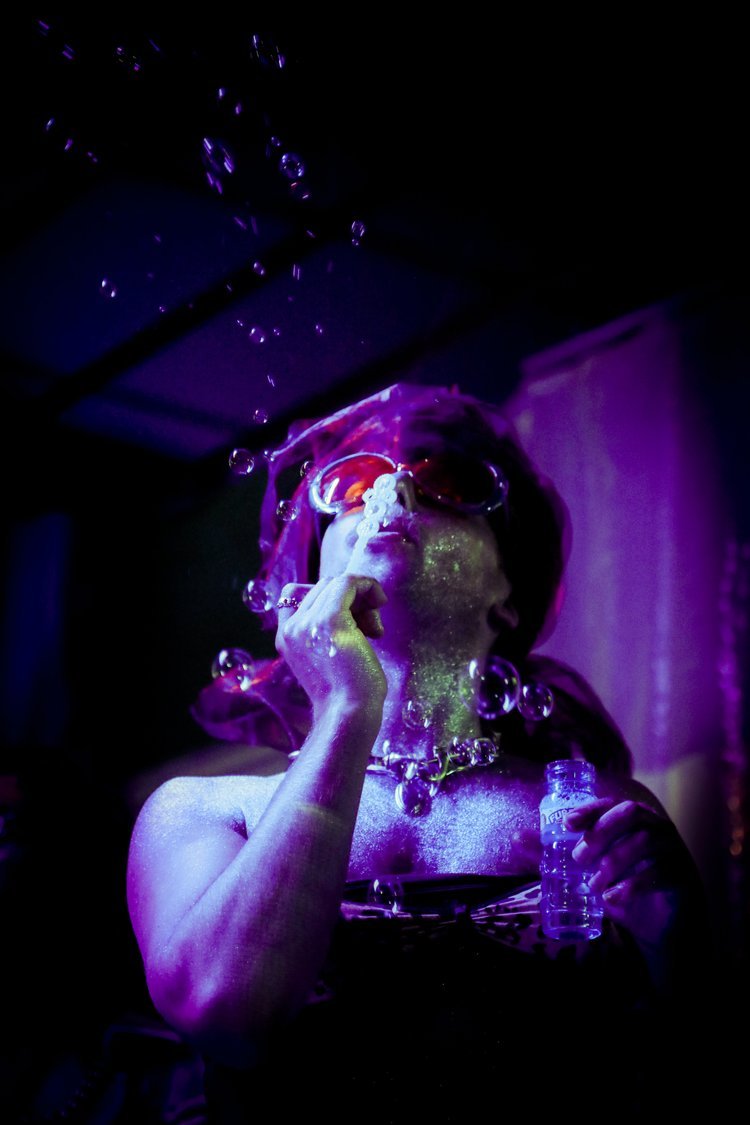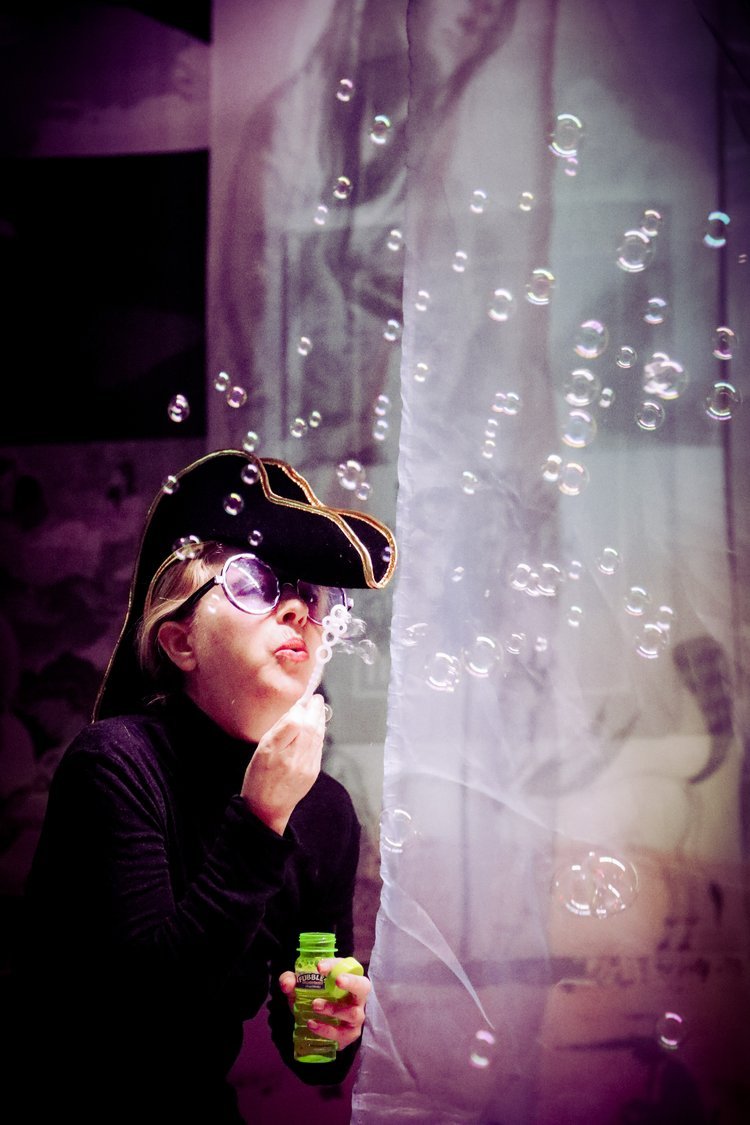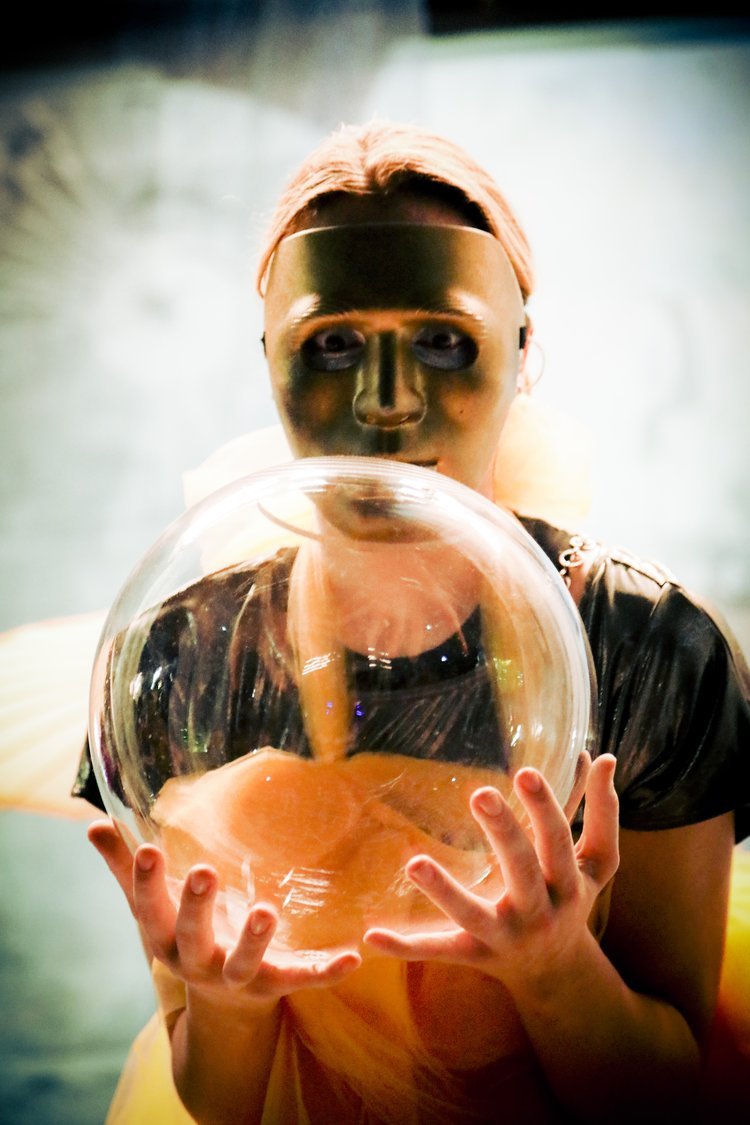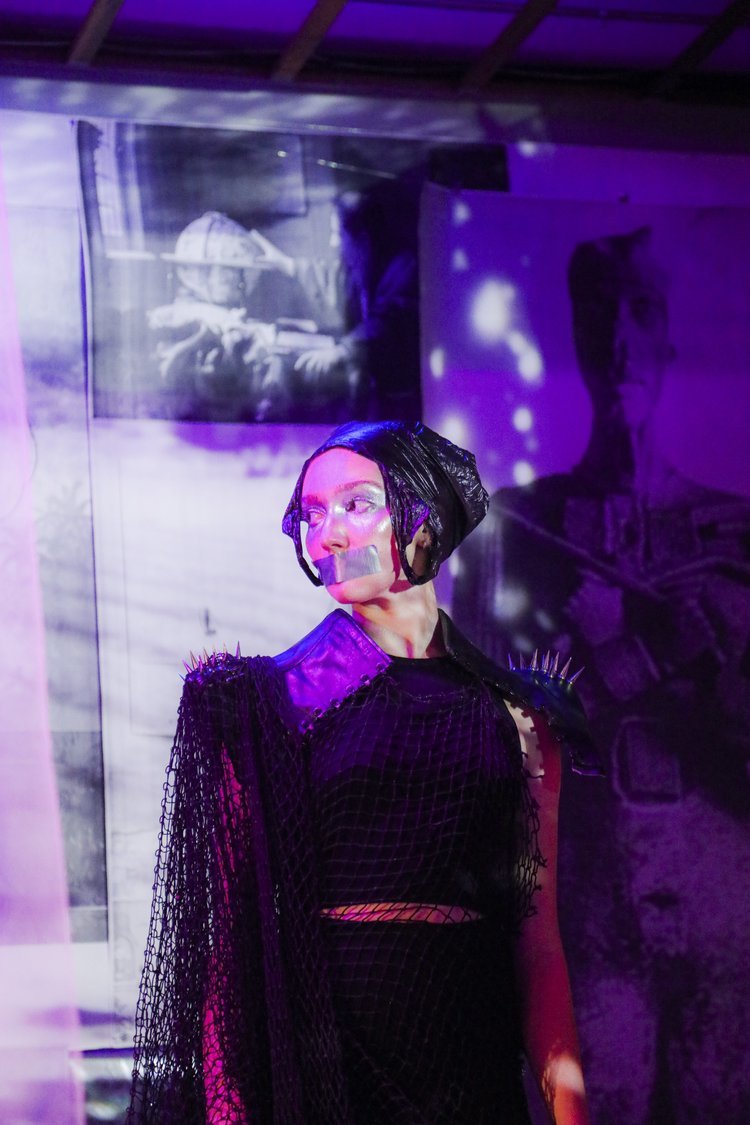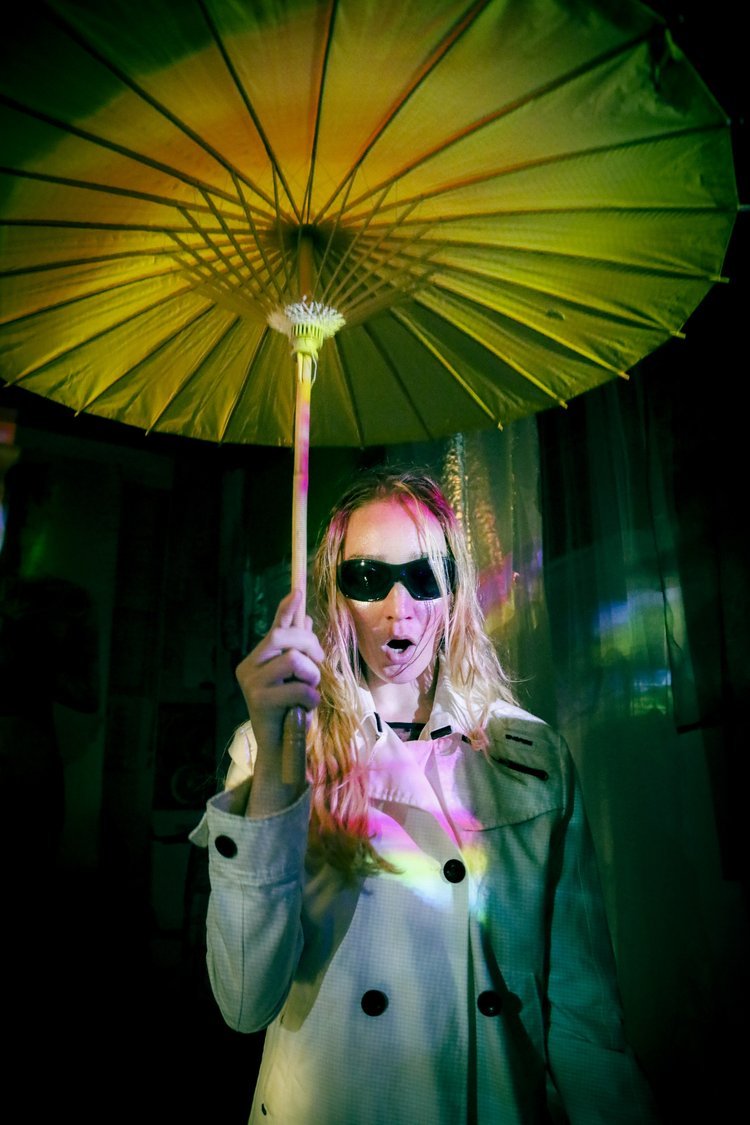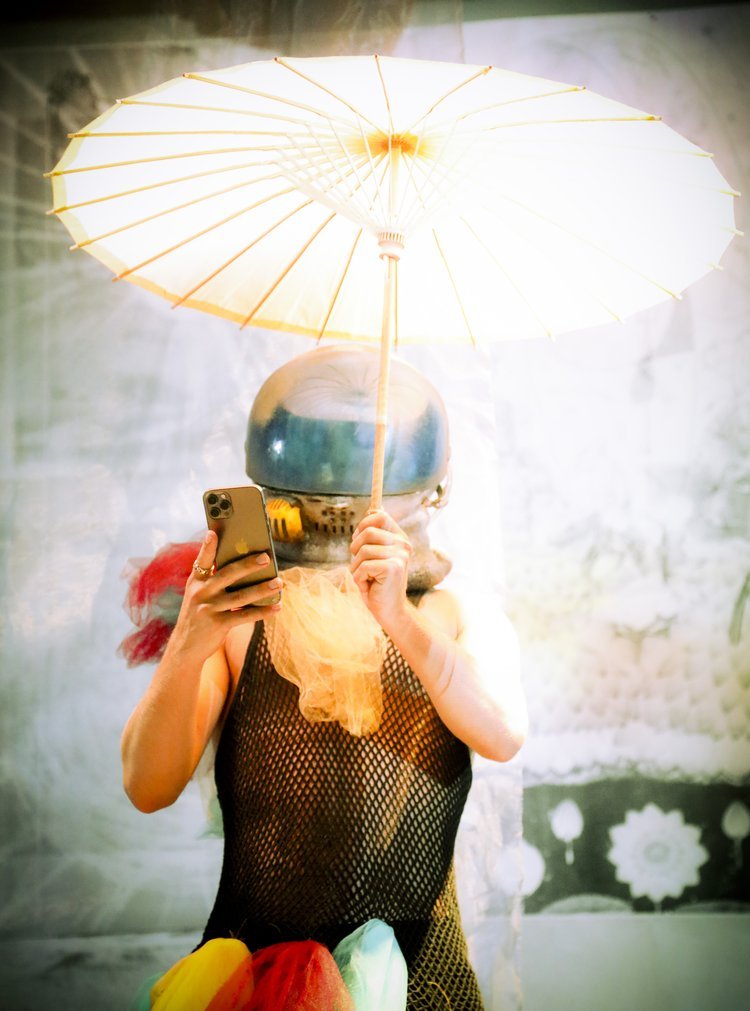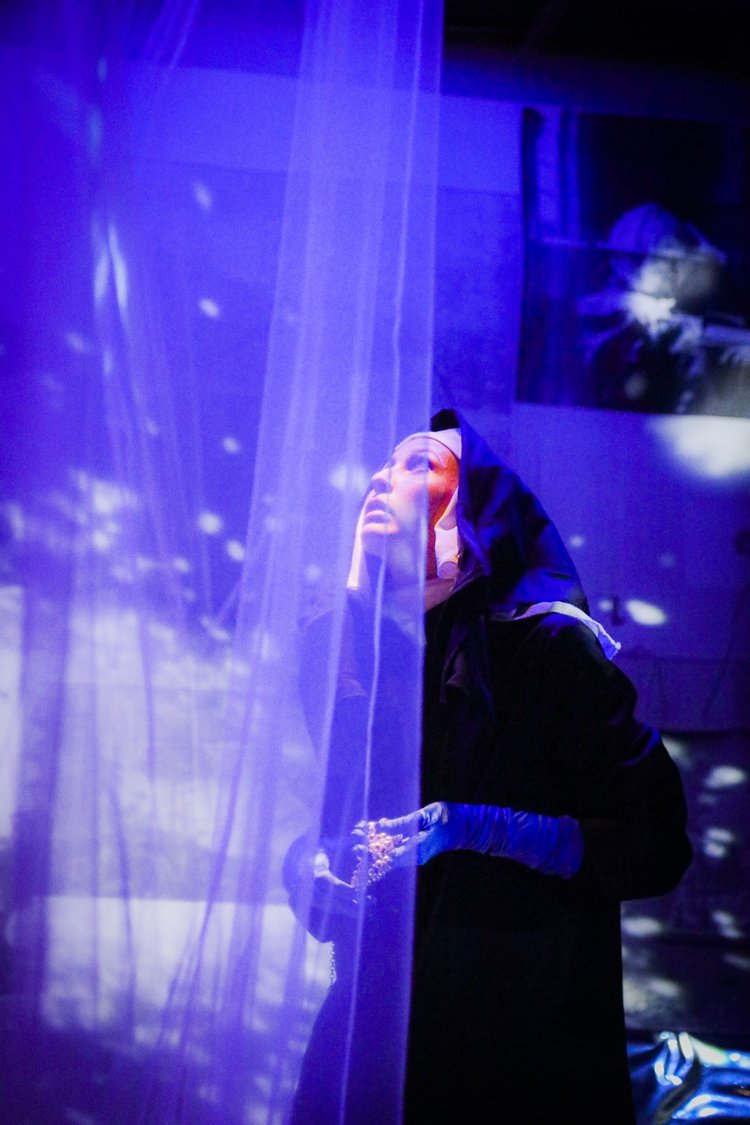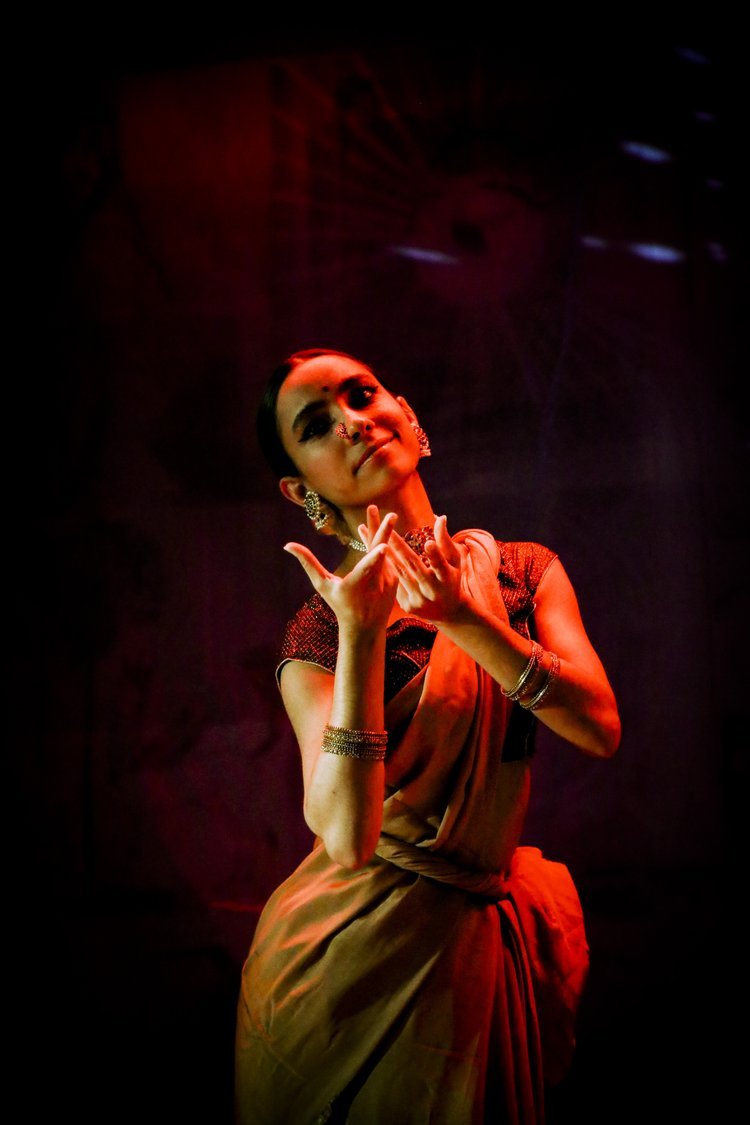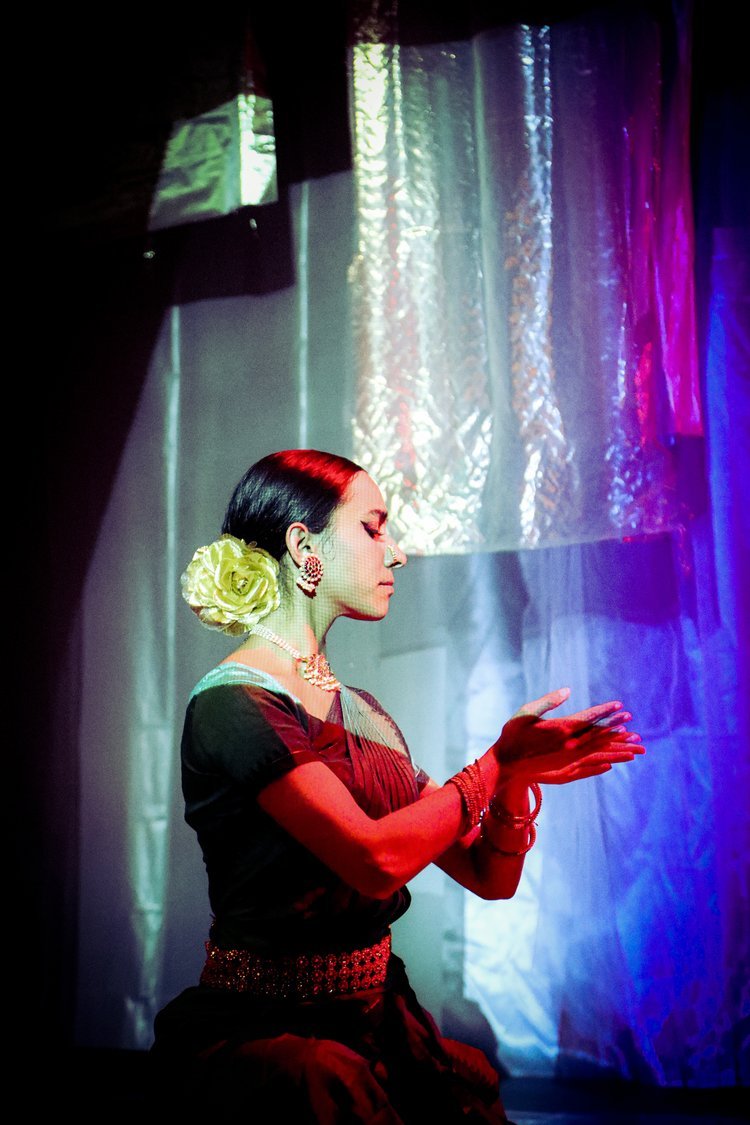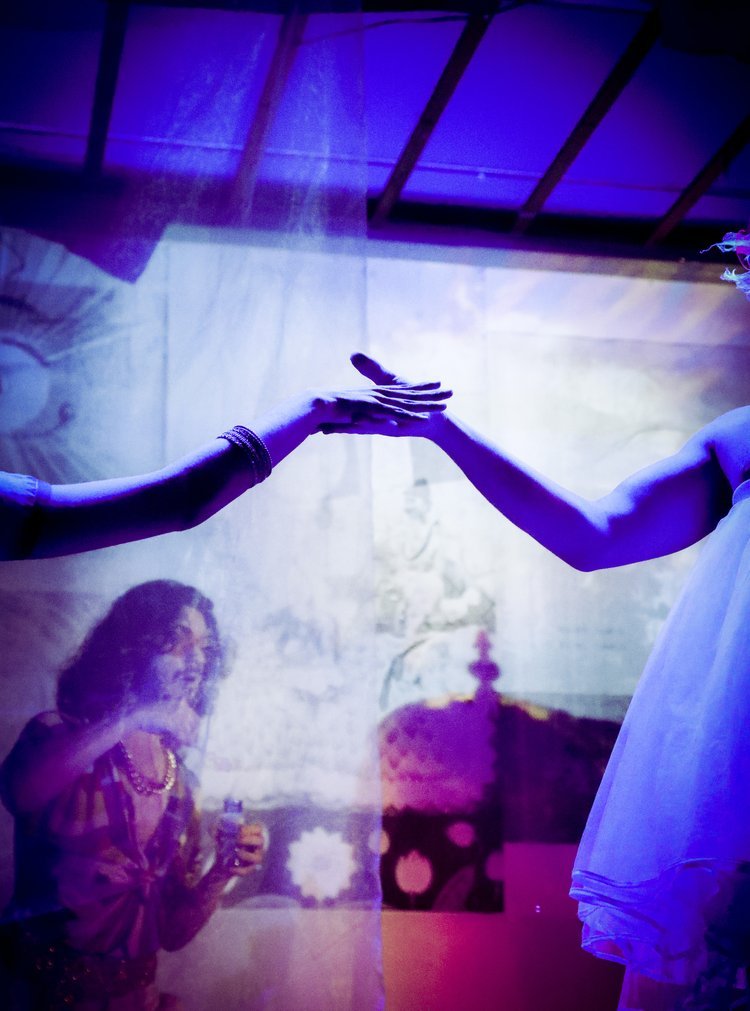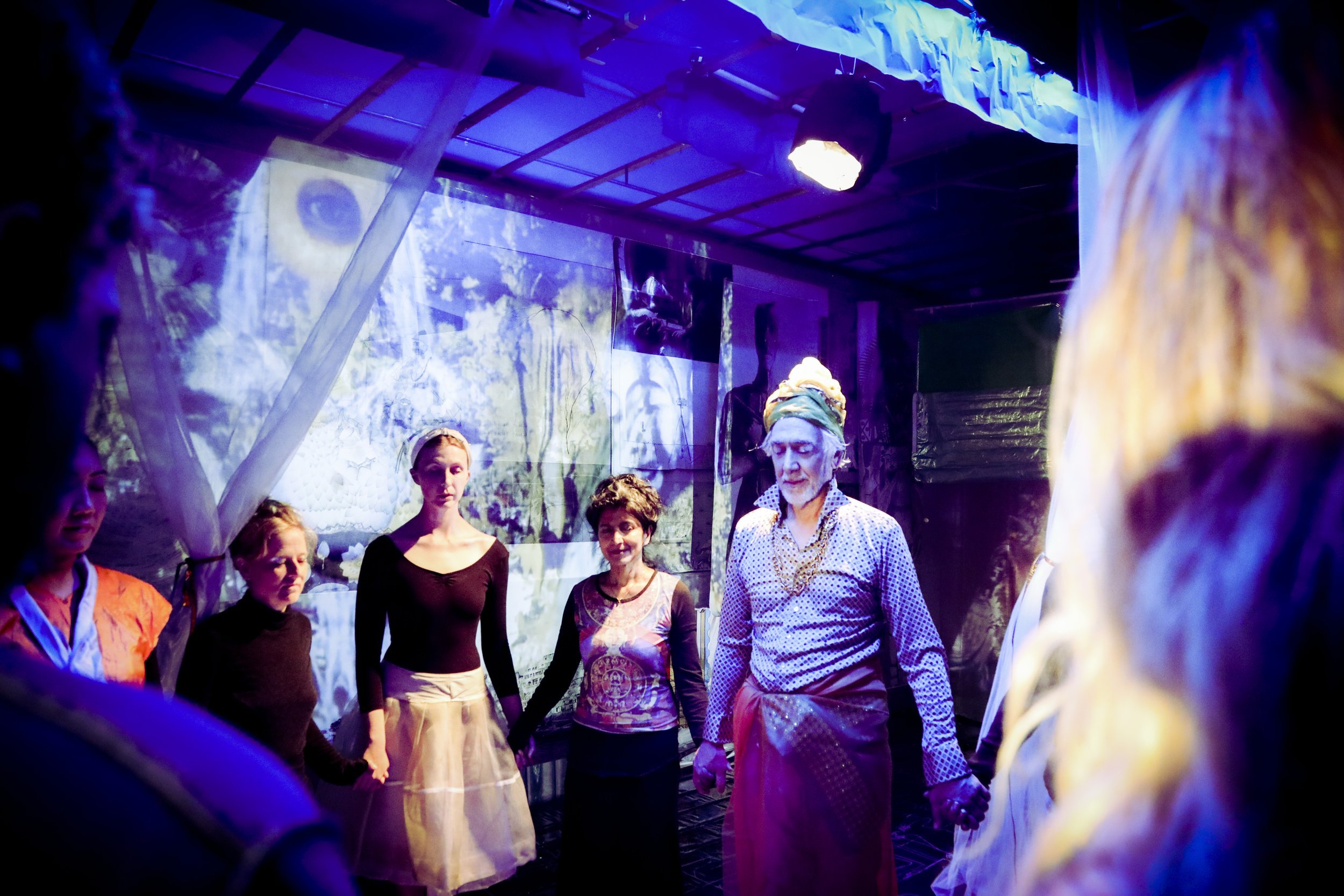practicing human
The Practicing Human in The Great Breath of Time
Marc Lafia with The Participatory Universe presents:
The Practicing Human In a The Great Breath of Time
A weekend in 2 parts
Written, directed and narrated by Marc Lafia
May 6 & 7, 2023
Five Myles Gallery Brooklyn, New York
This work of installation and performance consists of 5 distinct long form spoken word and scored prose poems, in total 473, each between 2 and 7 minutes long.
They are read, voice recorded, scored and performed live and video recorded for museum and gallery multi-screen installation. The work includes video and still image projections, sound works, collage paintings, drawings, site specific sculptures, choruses, narrators, masks performers, Butoh and classical Indian dancers, and other movement performers.
Practicing Human is a variable performance and theatre work: a work in many modes, a visually stunning and immersive project that takes viewers on a cross-cultural journey in search of the divine. Through ravishing images, poetic language, and performance, artist Marc Lafia delves into myth, history, anthropology, and contemporary science while addressing our modern obsession with AI. The experience invites reflection on the collective practice of being human, the timeless quest for transcendence, and the interconnectedness of all things.
The first performance of Practicing Human a cycle of works, was *Everything is Everything and There is Nothing Else, performed live in May 2019. You can see images and videos of this work on the pages of this site. For the weekend of May 6&7 we presented as visual Tableaux a selection of 97 prose-poem stories across the five individual works that make up the the Practicing Human cycle. These include 1) Everything is Everything and There is Nothing Else 2) Luxor, Can I Pass My Own Turing Test 3) Hong Kong, Revolution of Our Times Blah, Blah Blah, 4) Yangshuo, Lost to Wind and, 5) The Quantum Sutras of Shiva Shakti and the UFO’S.
They are performed in an image rich designed environment with a variety of movement performers including classical Indian dancers, contemporary dancers, Butoh and mask performers, mimes, performance artists, augmented projections, AI haptic suits, and audience participation and are recorded and filmed for museum and gallery installation.
About the Work
The Practicing Human is a work of installation and performance consisting of 5 individual, long form, scored prose works. Across these 5 works there are 473 total discrete poems, each between 2-7 minutes long. They are performed in an image rich, immersive environment with a variety of performers and dancers: mask performers, Butoh dancers, ecstatic dancers, Gurdjieff sacred dancers, classical Indian dancers, contemporary Indian dancers, mimes and acrobats with AI-augmented projections, haptic suits, and audience participation. The live performances are recorded and filmed for museum and gallery installation.
German philosopher, Peter Sloterdijk, has noted that humans live in habit, not in territories. All human life requires the cultivation of matters of body and soul, and all philosophies and religions have attended to this fundamental feature of our existence for all of time.
For Sloterdijk, the human being is above all a creature of repetition and artistry, a “human in training, the practicing human”. Not only is the earth the ascetic planet par excellence, as Nietzsche contended, it is also the acrobatic planet, par excellence.
And so, why not be an acrobat, keep traveling, in mind and body, to better understand how so many varied cultures went about this practicing. By taking these ideas into performance, into the theatre, into the communal, perhaps we can come to a displacement of our Western subject-hood, to see and feel and open ourselves up to other social arrangements, to see our lives as one particular practice: one amongst others.
Many cultures have desired to know the eternal and to live forever, and so built systems to create wealth and control. This continues today via all sorts of geo- political stratagems, resource wars, the imaginaries of life on Mars and life in the metaverse, billionaire island bunkers, and the not so imaginary climate reality, mass migrations, AI futurism, capital surveillance, and on and on and on. In our last performance, we started with Greeks and their articulation of tragedy, their movement from mythos to logos. This weekend, we turn to ancient Egypt and the middle east to examine monotheism, onto contemporary Hong Kong and its failed democratic revolution, and then traverse both ancient and contemporary China. The work intersperses a history of Hindu cosmology, and the ascetic practices of ancient India, onto Buddhism’s importation into California. From the transcendentalist to the Beats to early psychotherapeutic and psychedelic culture to today’s promise of AI and renewed interest in psychopharmacology, we continued our practicing.
And for what? Is the ‘epiphany’ no more than the substitution of one trainer for another? A repetition of the same with another name? Or perhaps an elongation, in a new direction. Let’s indulge such quandries this evening.
Reviews for Practicing Human
A magnificent evening of philosophical insights taking the shape of stunning visuals, moving bodies and beautiful language that capture the entirety of the senses. You are literally another person when coming out of it: a total work of art, and an art of the total work at its best. A transformative experience! -Chiara Bottici New School for Social Research, Associate Professor of Philosophy & Co-Director of Gender Studies
Epic! Gorgeous! Breathtaking artistry, where bodies become canvases and emotions become symphonies. -Oliver Herrington, Artist
*Reviews of LA Installation of Everything is Everything and There is Nothing Else
Communing with this work by Marc Lafia is like a frenzied trek back to the rituals of the Greeks. In Athens, theater was a great mystery, whose secrets still remain hidden.
But imagine: if bloody bull-fighting were combined with the solemn Catholic Mass, plus a military funeral, while training for the Olympics, and on a drug trip into the center of the galaxy.
The vast, political and cosmic scope of these festivities are far exceeding most contemporary theater-making—until Everything is Everything and There is Nothing Else, which propels beyond mere art and into the realm of fantastically reconstituting the weird core of reality itself.
Marc Lafia, throughout his thrilling career, has always combined a richly theoretical perspective with a lush and stimulating palette. Narrated by his own enchanting voice, the text spins an enveloping and incantatory yarn, while a tempest of dance and drama are a transport, through the mystic’s loss of self and into a shamanistic union of wholeness and toward the sheer joy of being alive.
-A.W. Strouse, Punctum
“Here it is!”
Is it a form of Hubris to attempt to be or do everything? The Greeks might think so, even though they were the first to attempt it. Everything is Everything by Marc Lafia is half experimental cinema, half art performance, half classical opera, half didactic documentary. That’s right: it is more than its whole, more than one. It recalls the sprawling mass of Sandinista, an album thought to be in serious need of editing, which actually reaches its masterpiece through its delicately balanced chaos and attempt to show the messy beauty of the “everything” of life. It recalls Syberberg in his attempt to merge artistic and didactic forms in a way uniquely demonstrating the mundane nature of contemporary categories. The philosopher Ken Wilber pursued the project of an “integral theory of everything” and paid the price for his Hubris. In all his books and his practices which explore integral philosophy, psychology, religion, and so on, he never developed an “integral art.” Here it is!
-Scott Von, Analytica
Tableaux Performed May 6&7, 2023
Saturday Part 1
Life is Vibration
My Pilgrimage to The East, The One You Came In Search
The Mirage of History
Kings and Their Seashells East-West, The Imaginary, The Real
The Ganges
intermission
MirrorWorld Hollywood Skeleton Crew, Paradise within Ourselves Call me Shakti
What is Grammar to a Hare Godhead
Hotel Delirium
Descent, Akhenaten and his Red Shoes, Krishna Dior
Sunday Part 2
Humans are Pet
Mars in Revolt
A Pinch of Psychedelic Mystical States of Consciousness The Temperature in Antarctica Today
Oceanic Feeling
The Void
intermission
I am at Sea
The Fruitful Earth and the Womb Delirium Pleasure and Attachment
Hanging in the Void
TelepathicMonastery
Down to Earth Everything Vanishes T
You Must Change the World Into Revolutionaries
Thisness and Suchness
Ensemble
Mary Abrams, Movement Performer
Chris Andrews, Lighting & Camera
Kendall Botjer, Movement Performer
Chris Venezuela Brown, Movement Performer
Corvette, Movement Performer
Brian Culligan, Sound Engineer
Matt Duncan, Detective of the Earth
Natalie Ginsberg, Dancer
Kassia Karrass, Art Assistant
Yamini Kalluri, Dancer
Yvette King, Art Consultant
Annie Kunjappy, Shakti
Ellen Ko, Movement Performer
Marc Lafia, Writer, Director, Artworks, Narrator
Andreea Mincic, Set Design, Costumes
Ayodamola Okunseinde, Akhenaton, Faust
David Pym, Projections
Chad Raines, Sound Design, Composition
Monica Sanborn, Movement Performer
Thanks
When we did the first performance of Everything is Everything and There is Nothing Else in May of 2019, I could not have imagined that I would spend the following five years on this project which is quite simply an artistic meditation on the many modes of the divine. It is an extraordinary subject to me, immensely vast and rich across time and cultures. As I write in one of the many, many prose poems, in the work, this notion of the divine was something I sensed and felt from a very young age. Something impalpable, effervescent, ephemeral, not at all strange and wholly of this world. The great permission of art is not knowing where something is going, but go you will as it takes hold of you and things seem then to find you and you find them. I have always loved reading, in fact books, music and art have always stood by me, and continue to be, well, some of my most intimate friends. The pleasure, the hazard in making art, to speak to art, is to gather up these intimate friends in a wild adventure that only comes to life in the doing.
For that I have many people to thank. One comment on language as a medium first. After a number of years working as a visual artist I began to think of an expressivity, an intimacy of language far removed from its use in both the critical and theoretical discourses I was trained in as a graduate in film studies, studying semiotics, psychoanalysis, gender and post colonial studies, deconstruction, etc as well as the language used by the Pictures generation such as Barbara Kruger, Jenny Holzer, John Baldassari, Louise Bourgeois inveighing language through either analytic philosophy, or the rhetoric of advertising and psychoanalysis - and so thought of language as a poetic form that expresses images for the listener to conjure. An excess of language that would be grounded and then take flight from the everyday and cascade with my many thoughts and feelings. Kind of drawing with words. Yes I wanted to bring an effusion of language into the contemporary. And with these first writings I thought, what of scoring this. And so I found my principal collaborator in the musician, composer, sound designer, Chad Raines, who would go on to score 472 discrete pose poems of the over 500 I had written. Listening to his score and design was always an extraordinary delight for me, as it was if hearing him reading, reading musically, sonically the words I had written. I was also very fortunate to meet Andreea Mincic, the production designer and costumer. From the moment she came to my home, she seemed to know exactly how to gather all the right elements to create the perfect design to present the work. In both performances she would work intimately with the projectionists, Gil Sperling and in this work David Pym. Both of whom were superb. Lighting and camera would also be so essential to the work, to create images, so many thanks to Chris Andrews who would light and do camera for both these works. But how to stage this work. With whom and how is it to be performed. And what could that express. I will write more on this later. I want to give great thanks to each performer, each whom I think was exquisite and perfect, this includes Mary Abrams, Kendall Botjer, Chris Venezuela Brown, Corvette, Matt Duncan, Yvette King, Natalie Ginsberg, Yamini Kalluri, Annie Kunjappy, Ellen Ko, Ayodamola Okunseinde and Monica Sanborn. Each of them was incredible and each of them truly attuned to their collaborators. Thanks to Olivia Wien for these gorgeous images and to Brian Culligan for going through the sound poems again and again as I kept working towards the select 97 poems we would present over the two evenings. A very special thanks to Lucy Roreck who early on offered to support the project and gave me the courage to do it, to Dominique and Eric Sloan for their generous support, to Jose Fernandez and to the very magnanimous Hanne Tierne who invited us to present the work at the Five Myles gallery.
Practicing Human consist of 5 long form prose poems. 1) Everything is Everything and There is Nothing Else 2) Luxor 3) Hong Kong, Revolution of Our Times Blah, Blah Blah, 4) Yangshuo, Lost to Wind and 5) The Quantum Sutras of Shiva Shakti and the UFO’S.
Each is scored and a discrete work on its own. Across the 5 works there are 473 total poems, between 2-7 minutes long. They are performed in an image rich designed environment comprised of many of my drawings, paper and light sculptures, and a variety of movement performers including classical Indian dancers, contemporary dancers, Butoh and mask performers, mimes, performance artists, augmented projections, AI haptic suits, and audience participation and are recorded and filmed for museum and gallery installation.
The Practicing Human is part experimental cinema, performance art, classical opera, didactic documentary, science fiction, travelogue, art and history lecture. Through out ask who exactly speaks these histories and to what end? It is both a solitary and communal practice of many modes of embodiment, a coming into the attentiveness of awareness, self and other.
What at follows is a brief summary of each of the works.
Everything is Everything and There is Nothing Else (134 poems, 4 hours 35 minutes)
Everything is Everything and There is Nothing Else is the first of 5 epic non-epic prose poems, written as a travelogue and set in contemporary Greece as a starting point to ruminate on exile, perhaps the most pressing issue of our time.
Just as the ‘archaic Greeks’ move to the ‘classical’ Greeks, the 134 spoken and scored prose poems move along a spectrum from the ecstatic or instinctual to reason, and from mythos to logos.
The work was performed and recorded with a live audience of 90 people on May 11th, 2019 at Nowhere Studios in New York City and began traveling in exhibition as a video installation, September 2022 showing at the Libertine Gallery in Los Angeles, CA.
Luxor, can I pass my own Turing Test (154 poems, 10 hours 30 minutes)
*Due to the Covid pandemic, Works 2-4 were recorded as audio works. Future performances may be considered.
Where in the first piece the story picks up from the canon of western liberalism, the move from myth to reason, the Greeks and western philosophers, and the anomie that comes with the death of god, here our story ventures further back in time and asks what can we learn from the Ancient Egyptians whose culture, religion and state apparatus, might be more pertinent to the future than we may have imagined. As we did in Everything is Everything, here we cross cut between the older funerary and magic saturated cultures and civilizations of Egypt and Arabia as its polytheism becomes monotheism, to the psychedelic and techno cultures of Burning Man, Las Vegas and Silicon Valley.
If the question of exile was pre-eminent in Everything is Everything, the question of “we” is at the heart of poem two, Luxor. If exile suggests an exit, Luxor tells us that “we” have nowhere to go but to turn to each other. Only a ‘we’ can take ‘us’ in a new direction. And that in this notion of ‘we’, if it exist at all, who and what has agency, and what kind become the pressing questions. Perhaps there is a myriad of many more living things in this world that we should want to be in touch with, who indeed have consciousness and being, like ice cores, deserts, winds, trees and mushroom networks, tides, glaciers, and geologic plates; they must be part of ‘we’.
In Luxor the story teller recounts their travels to the great pyramids of Egypt, contemporary Cairo, the Bedouin deserts of Wadi Rum, the under water coral in the Red Sea, and Nevada. In Luxor the question of exile moves to an idea that there is no outside, no bunker in New Zealand, no upload of consciousness that can resolve one’s utopic yearnings or desires of immortality. On a Nile Cruise, the narrator becomes initiated in the Egyptian Antiquarian society and is trained to time travel to the astral planes and see the akashic records and the agency in all living and non-living things. In Wadi Rum, in the desert, amongst thousands of sheep s/he is visited upon by The Construct and in time deployed after becoming-woman to the great Pussy Riots of the 2020’s in Luxor Nevada.
Hong Kong, Revolution of Our Times Blah, Blah Blah (28 poems, 70 minutes)
When a mysterious invitation comes from a Hong Kongese avalanche rescue student by the name Min, our narrator travels to Hong Kong to better understand the passions and logistics of the Umbrella Movement. They learn of the writing community of Hong Kong, many of whom are exiles from Shanghai who have made Hong Kong their home. One is Min’s uncle, a book publisher, who along with the famed film director Wong Kar Way tells us about Hong Kong, its languages, cultures and costumes. Min tells us of how the revolution failed. “Blah Blah Blah,” she says and yet there is some solace as she and I go to a green mountain, above the heavens and naked in the rain walk amongst 100’s of Buddhas in a sun shower. And so for a moment, believing Min, my soul mate, I am in love until she reveals herself as a member of an orchid eating cult and is a simulacrum working for a robotics multinational. Oh my!
And so exiled from himself, from the very hope of the ‘we’, and the Blah Blah Blah of it all, our narrator falls into a great despair, feeling an immense sorrow at the ineffectiveness of collective action to affect change. And what is he alone, in the most densely populated city in the world. The narrator under conditions of severe heat and humidity on the Island of Hong King, suffers a break down. His breaking down, he feels is the very breaking down of the planet, of his ego, of an any identity at all.
As the monsoon continues, under wet bulb conditions the narrator finds himself in the slippage of time on Mars in 2042 prosecuting a trial of Elon Must who had murdered a robot. When the heat subsides he returns back to his body and goes to a Butoh performance where Min dances with the great Butoh innovator, Akaji Maro. At the after party he makes a silent connection to Maro and walks int the dark night and rain under the aegis of what he believes now are his two masters, Akaji Maro, the Japanese Butoh dancer, and Thich Nhat Hanh, the Vietnamese Buddhist poet and monk.
Yangshuo, Lost to Wind (35 poems, 50 minutes)
In Lost in Wind, I go to Mainland China, imagine my life as a hermit, studying the history of rice and the Tao while staying in Yangshou at the Zen Inn with elite Chinese rock climbers, neuro-linguistic programmers and a quantum activist that relay to me the idea of shaping man through training regimes recounting the cultural revolution and the contemporary surveillance state.
I meet hermits, take long bicycle rides and walks in the beautifully cultivated rice fields of the Karst mountain valleys. But soon enough my attention turns to the social political technocratic aspirations of the 20th Century to remake and refashion human societies. Here we re-stage the dreaded struggle sessions of the Red Guards and see in a sense the horrors and madness of the ‘we’, of the all against all. What was the promise of the collective. We me I discourse on the Chinese Communist Party, its formation and vectors of control, language, rank, force, purges, taken up in the madness of the cultural revolution and those that made it. And so contrast the mystic and the commissar, the contemplative and the revolutionary.
The Quantum Sutras of Shiva, Shakti and the UFO’s (122 poems, 4 hours 25 minutes)
In search of ‘real wisdom’ and inner peace, the narrator and his lover, his double, go to India. The two decamp in Varanasi and find themselves involved in the city’s rich history and many of its local residents, including musicians, booksellers, tailors, and pilgrims. As they see each other, the lovers, fold into the whole of time and its conception, and as one, and then the other, they perform and tell us stories of the meditative and musical practices of the ancient Hindus and the Buddhist notions of cyclical time, dharma, death and rebirth. Through the days, weeks, centuries and millennium of their travels, the lovers consider how the mappings of the mind, of the divine, and how the great wisdom of the East are taken up by the west.
They recount stories of the early American transcendentalists, soirees of the great sages and swamis that came to America starting in the late 1890’s, onto the Quantum physicists, the Beats, and many of the those that were involved in The Human Potential Movement and all of it amplified by psychedelics until at last, we voyage with our narrators to the Akashic records beyond space time, and tune to the OM of the world.
